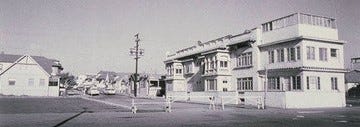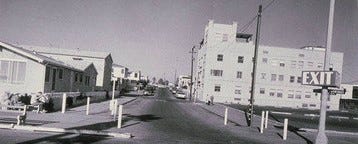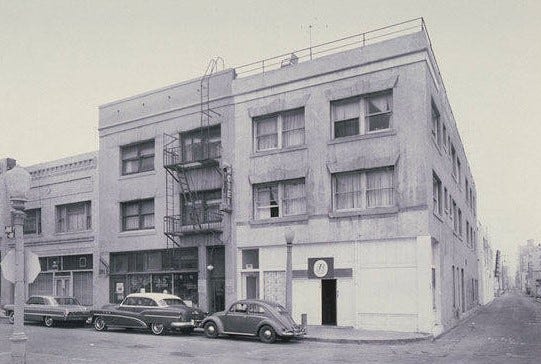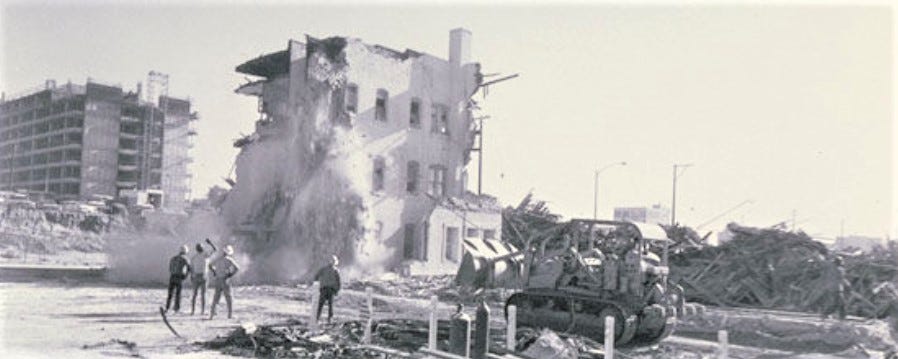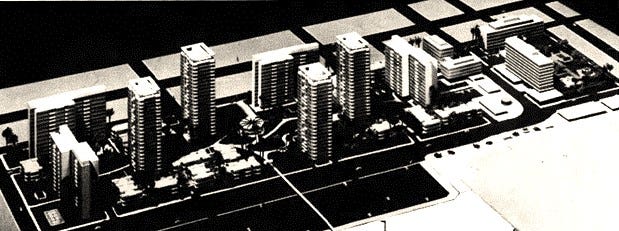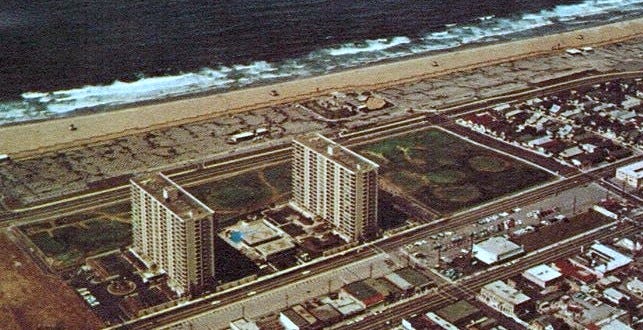The Street Seen: Ocean Park Redevelopment Project
West of Neilson from Ocean Park Blvd south to the city border
In 1965, everything (except the Marine Street Telephone Exchange building) west of Neilson between Ocean Park Blvd and the south city border is demolished for a City of Santa Monica urban renewal project.
Arguably, the Ocean Park Redevelopment Project has its origins in the Santa Monica municipal elections of 1955. Midcentury Ocean Park is a hodgepodge of oceanfront motels, food and drink concessions, cheap apartment buildings, and old-fashioned beach bungalows. Ocean Park’s dilapidated urban landscape acts as a magnet for sleazy and criminal characters. On the pier, gambling concessions masquerading as “games of skill” proliferate. Two candidates, Trinity Baptist pastor Fred Judson, and 27-year-old lawyer Rex Minter, denounce the “laxity and apathy in law enforcement.”
Judson and Minter are elected in 1955, and proceed to make good on their promises to clean up Ocean Park. The Santa Monica Redevelopment Agency (SMRA), a public body in charge of drafting urban renewal plans for the city, is formed in 1957.1
In 1958, the SMRA selects a 45-acre Ocean Park beach strip (west of Neilson from Ocean Park Blvd south to the city border) as its first re-development project. The first stage of the project, Project I(a) is mostly residential and provides 1,800 units; while Project I(b) will be developed later for commercial purposes.
In 1961, with a $2.5 MM loan backed by the US Federal Housing and Home Finance Agency (HHFA), SMRA begins purchasing the land parcel by parcel.2 In 1965, buildings are demolished and streets closed.
The displacement of the 1,216 people forced to leave their Ocean Park dwellings is widely denounced. Rents in the Santa Monica Shores are 5 to 10 times higher than those prior to the demolitions, making it impossible for residents to stay in their old neighborhood. For many of the old Jewish residents, who used to sit and chat on the oceanfront benches, nothing can replace the community and the view they had enjoyed in Ocean Park. With no public housing available in Santa Monica, the vast majority of residents are relocated far from the beach.
In 1965, a joint venture between the Del E. Webb Building Company and the Kern County Land Company is selected to build 8 high-rise apartment buildings, a shopping center, and a motel on the 26.3 acres encompassed by Project 1(a).
Two towers are built, but financing issues block the construction of additional towers. By 1972, only 5 of the 26 acres of cleared-out property have been redeveloped.3
In 1971, a new private company is selected by the City Council to build nine 29-story towers and a hotel on the oceanfront.
In 1972, the California Coastal Commission (CCC), a new public agency in charge of reviewing building permits for construction within one mile from the shoreline, is formed. The Coastal Commission sides with “Save Santa Monica Bay” activists, and cancels the developer’s permits, thus ending the project.
Composed of 5 members appointed by the Mayor, the Santa Monica Redevelopment Agency is advised by the Santa Monica Citizen’s Progress Committee (SMCPC) - a group of 50 “community leaders.”
259 separate parcels of land are acquired. When the buildings that stood on them are demolished, 316 families, 502 individuals, and 212 businesses have to be relocated
The legacy of the Ocean Park redevelopment project is one of trauma, frustration and disappointment - in social, political, and economic terms. At a cost of $14 million, the City eliminated a neighborhood and replaced it with 532 nice apartments. …”dreams beyond the capacity of the community to perform” former Mayor Nat Trives.




